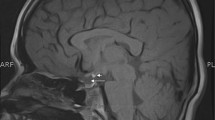Abstract
We report the case of a 17-year-old girl presenting short stature (height 149 cm, below the 3rd percentile), obesity (weight 83.5 kg, body mass index 37 kg/m2) and secondary amenorrhea, in whom endocrinological evaluation disclosed an absolute lack of GH responsiveness to both supra-pituitary challenges and repetitive growth hormone releasing hormone administration together with failure of plasma gonadotropins and PRL, low under basal conditions, to rise in response to GnRH and insulin-hypoglycemia, respectively. In contrast, basal and stimulated TSH and ACTH secretions were normal. Radiological examination of the skull revealed virtual absence of the pituitary fossa due to the lack of sellar cavum and dorsum, while magnetic resonance was unable to detect any pituitary tissue. A mucosal cleft of the nasopharynx, compatible with a pharyngeal hypophysis, was disclosed at endoscopy. This is an unusual case of developmental abnormality including lack of formation of the sella turcica and incomplete caudal migration of the embryonal anterior pituitary, resulting in ectopically located-likely pharyngeal — pituitary tissue. In view of the occurrence of spontaneous menarche and of a growth impairment less severe than one would expect considering the degree of GH deficiency, it is conceivable that the ectopic pituitary tissue has lost, in time, some of its secretory ability.
Similar content being viewed by others
References
Fisher R.L., Di Chiro G. The small sella turcica. Am. J. Roentgenol. 91: 996, 1964.
Frances J.M., Knorr D., Martinez R., Neuhauser C. Hypophysarer zwergwunghs bei lippen-kiefer-spalte. Helv. Paediat. Acta 24: 576, 1966.
Riach I.C.F. The pituitary fossa in children with particular reference to hypopituitarism. Br. J. Radiol. 39: 241, 1966.
Stanhope R., Hindmarsh P., Kendall B., Brook C.G.D. High resolution CT scanning of the pituitary gland in growth disorders. Acta Paediatr. Scand. 75: 779, 1986.
Di Natale B., Scotti G., Pellini C., Del Maschio A., Triulzi F., Petecca C., Uboldi F., Chiumello G. Empty sella in children with pituitary dwarfism: does it exist? Pediatrician 14: 246, 1987.
Carstens M. Die Selladiagnostik. Fortschr. Rontgenstr. 71: 257, 1949.
Ale G., Morabito F., Bisacchi U. Studio della capacità cranica e della superficie sellare nel nanismo ipofisario e costituzionale. Presentazione di un caso di anomalia sellare di Carstens. La Radiologia Medica 52: 1273, 1966.
Tanner J.M., Whitehouse R.H. Clinical longitudinal standard for height, weight, height velocity, weight velocity and stages of puberty. Arch. Dis. Child. 51: 170, 1976.
Greulich W.W., Pyle S.I. Radiographic atlas of skeletal development of the hand and wrist. Stanford University Press, Stanford, 1959.
Bokelmann O. Die spezielle Anatomie der Sella Turcica und ihre klinische Bedeutung. Fortschr. Rontgenstr. 49: 364, 1934.
Ferrier P.E., Stone E.F. Familial pituitary dwarfism associated with an abnormal sella turcica. Pediatrics 43: 858, 1969.
Sipponen P., Simila S., Collan Y., Autere T., Herva R. Familial syndrome with panhypopituitarism, hypoplasia of the hypophysis, and poorly developed sella turcica. Arch. Dis. Child. 53: 664, 1978.
Ozer F.L. Pituitary dwarfism with retinitis pigmentosa and small sella turcica. Birth Defects 10: 354, 1974.
Blizzard R.M., Alberts M. Hypopituitarism, hypoadrenalism and hypogonadism in a newborn infant. J. Pediatr. 48: 782, 1956.
Mosier H.D. Hypoplasia of the pituitary and adrenal cortex: report of occurrence in twin siblings and autopsy findings. J. Pediatr. 48: 633, 1956.
Ehrlich R.M. Ectopic and hypoplastic pituitary with adrenal hypoplasia. J. Pediatr. 51: 377, 1957.
Reid J.D. Congenital absence of the pituitary gland. J. Pediatr. 56: 658, 1960.
Steiner M.M., Boggs J.D. Absence of pituitary gland, hypothyroidism, hypoadrenalism and hypogonadism in a 17-year old dwarf. J. Clin. Endocrinol. Metab. 25: 1591, 1965.
Johnson J.D., Hansen R.C., Albritton W.L., Werthemann U., Christiansen R.O. Hypoplasia of the anterior pituitary and neonatal hypoglycemia. J. Pediatr. 82: 634, 1973.
Sadeghi-Nejad A., Senior B. A familial syndrome of isolated “aplasia” of the anterior pituitary. J. Pediatr. 84: 79, 1974.
Pellini C., Di Natale B., De Angelis R., Bressani N., Scotti G., Triulzi F., Chiumello G. Growth hormone deficiency in children: role of magnetic resonance imaging in assessing aetiopathogenesis and prognosis in idiopathic hypopituitarism Eur. J. Pediatr. 149: 536, 1990.
Maghnie M., Triulzi F., Larizza D., Preti P., Priora C., Scotti G., Severi F. Hypothalamic-pituitary dysfunction in growth hormone-deficient patients with pituitary abnormalities. J. Clin. Endocrinol. Metab. 73: 79, 1991.
Vannelli S., Avataneo T., Benso L., Potenzoni F., Cirillo S., Mostert M., Bona G. Magnetic resonance and the diagnosis of short stature of hypothalamic-hypophyseal origin. Acta Paediatr. 82: 155, 1993.
Kopelman P.G., Noonan K., Goulton R., Forrest A.J. Impaired growth hormone response to growth hormone releasing factor and insulin-hypoglycaemia in obesity. Clin. Endocrinol. (Oxf.) 23: 87, 1985.
Ghigo E., Procopio M., Maccario M., Bellone J., Arvat E., Campana S., Boghen M.F., Camanni F. Repetitive administration fails to increase the response to GHRH in obese subjects. Evidence for a somatotrope defect in obesity? Horm. Metab. Res. 25: 305, 1993.
Cordido F., Casanueva F.F., Vidal J.I., Dieguez C. Study of insulin-like growth factor I in human obesity. Horm. Res. 36: 187, 1991.
Loche S., Cappa M., Borrelli P., Faedda A., Crino A., Cella S.G., Corda R., Müller E.E., Pintor C. Reduced growth hormone response to growth hormone-releasing hormone in children with simple obesity: evidence for somatomedin-C mediated inhibition. Clin. Endocrinol. (Oxf.) 27: 145, 1987.
Boyd J.D. Observations on the human pharyngeal hypophysis. J. Endocrinol. 14: 66, 1956.
Author information
Authors and Affiliations
Rights and permissions
About this article
Cite this article
Scacchi, M., Alé, G., Silvestri, P. et al. Abnormal development of the sella turcica and lack of pituitary visualization in a patient with partial hypopituitarism. J Endocrinol Invest 18, 391–395 (1995). https://doi.org/10.1007/BF03347844
Received:
Accepted:
Published:
Issue Date:
DOI: https://doi.org/10.1007/BF03347844




